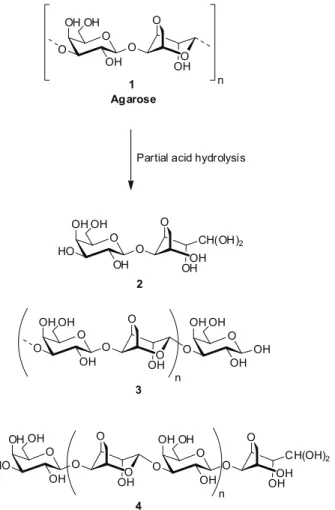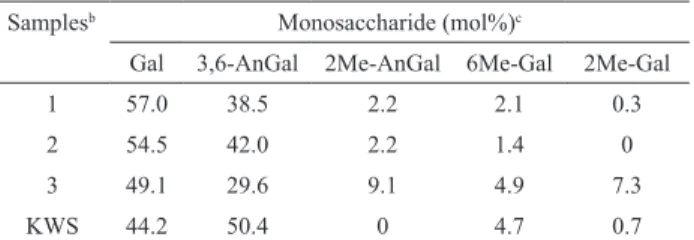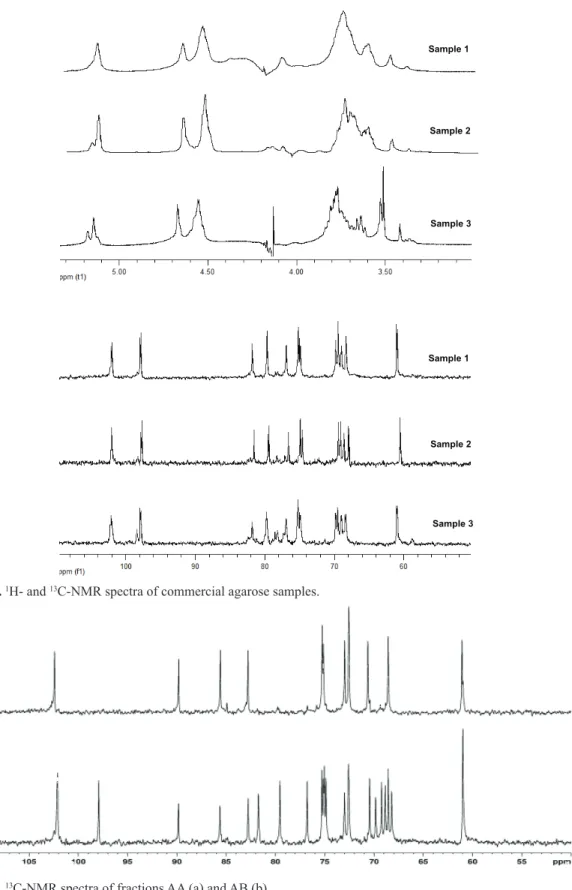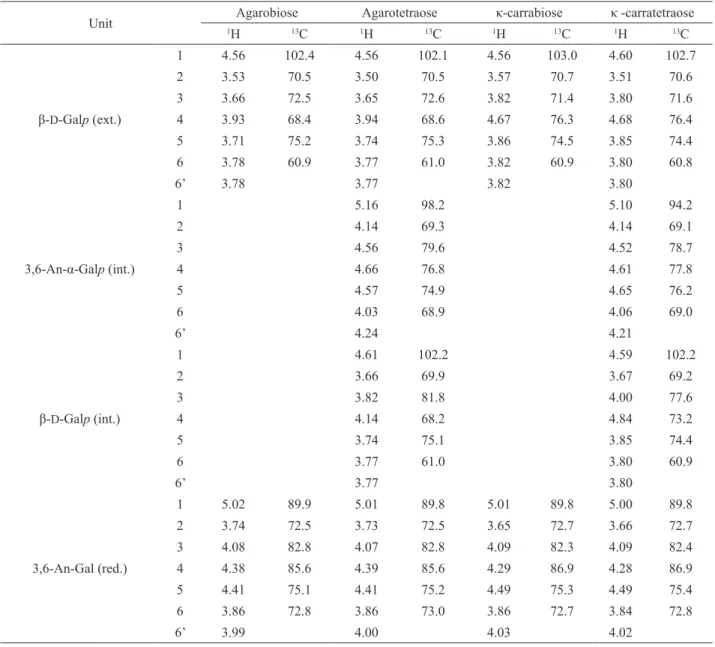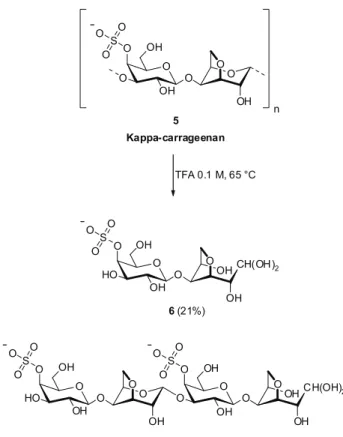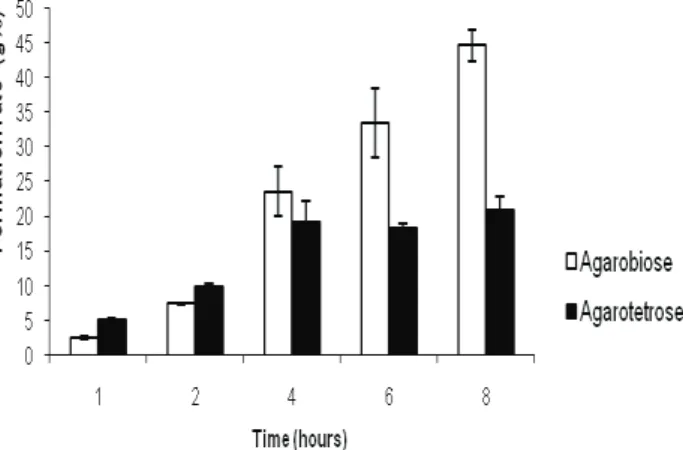Article
ISSN 0102-695X
doi: 10.1590/S0102-695X2011005000080 Received 8 Jan 2011
Accepted 28 Jan 2011 Available online 13 May 2011
oligosaccharides by partial acid hydrolysis
of galactans
Diogo R. B. Ducatti,
1Franciely G. Colodi,
1Alan G. Gonçalves,
2M. Eugênia R. Duarte,
1Miguel D. Noseda
*,11Departamento de Bioquímica e Biologia Molecular, Universidade Federal do Paraná, Brazil,
2Departamento de Farmácia, Universidade Federal do Paraná, Brazil.
Abstract: Agaro- and carra-oligosaccharides were produced by partial acid hydrolysis of commercial agarose and kappa-carrageenan. Di- and tetrasaccharides were purified by gel filtration chromatography and characterized by NMR (1D and 2D) spectroscopy and ESIMS. The following oligosaccharides were obtained: agarobiose, agarotetraose, kappa-carrabiose and kappa-carratetraose. Agarobiose and agarotetraose were used as standards to develop a high performance size exclusion chromatography (HPSEC) method which was utilized to study the hydrolysis rate of agarose and oligosaccharide production. Six hours of hydrolysis (0.1 M TFA, 65
oC) produced mainly di- and tetrasaccharides. The methodology for oligosaccharide
production and evaluation developed in the present work shows good potential for the production of bioactive oligosaccharides.
Keywords:
agaro-oligosaccharides carra-oligosaccharides partial acid hydrolysis 3,6-anhydro-galactose agarose
kappa-carrageenan
Introduction
Red seaweeds produce linear galactans as the principal constituent of the extracellular matrix. Chemically, these polymers consist of alternating
(1→3)-linked β-D-galactopyranose and (1→4)-linked
α-galactopyranose units. Frequently, the 4-linked
units are in the 3,6-anhydro form. These polymers are
classii ed according to the stereochemistry of the 4-linked
units into agarans (L-enantiomer) and carrageenans (D-enantiomer) (Painter, 1983; Craigie, 1990). Recently, a third group, denominated D/L-hybrids and containing D and L enantiomers of the α-Galp units (Zibetti et al., 2005; Zibetti et al., 2009) has emerged. Agarans and carrageenans can present complex substitution patterns due to the presence of sulfate, methyl, 4,6-O -(1’-carboxyethylidene) and glycosyl groups (Craigie, 1990).
Galactan oligosaccharides can be obtained through partial acid (Yu et al., 2002; Gonçalves et al.,
2010; Ciancia et al., 2005) or enzymatic hydrolysis
(Guibet et al., 2006; Young et al., 1978; Rochas et al.,
1994). Usually, the partial acid hydrolysis methods
(Figure 1) promote the specii c cleavage of 3,6-anhydro-α-galactosidic bonds to produce the reducing di- or
tetrasaccharides 2 and 4, containing the unusual anhydro galactose in hydrated aldehyde form as the terminal unit.
These oligosaccharides can be isolated and characterized (Miller et al., 1982; Fatema et al., 2010) and even used as starting materials to synthesize carbohydrate building blocks (Ducatti et al., 2009). However, due to the instability of 3,6-anhydro-galactose units to harsh acidic conditions, partial hydrolysis with strong and concentrated acids can also produce the reducing trisaccharide 3 containing galactose as the terminal unit (Yang et al., 2009). A good alternative for preserving the anhydro units is the addition of reducing (Usov &
Elashvili, 1991; Gonçalves et al., 2002) or oxidizing (Penman & Rees, 1973) agents during the hydrolysis
step to produce alditol or aldonic oligosaccharides, respectively.
Galactan oligosaccharides and their derivatives can exhibit signii cant antioxidant (Chen & Yan, 2005),
antitumoral (Haijin et al., 2003) and antiangiogenic (Chen
et al., 2007) activities. In particular, oligosaccharides
and compounds containing the reducing 3,6-anhydro-L-galactose unit, such as agarobiose, agarotetraose and agarohexaose can suppress nitric oxide, prostaglandin E2
and pro-inl ammatory cytokine production in vitro (Enoki et al., 2010; Kobayashi et al., 2003). The presence of the anhydro unit at the reducing terminal end appears to play a crucial role in these activities.
oligosaccharides in the pharmaceutical and food
industries, production protocols (Enoki et al., 2007) have
been developed. In addition, chromatographic methods are utilized to control the hydrolysis process (Chen et al., 2004; Kazlowski et al., 2008), being useful for monitoring bioactive oligosaccharide production.
In this paper we describe the production and characterization of agaro- and carra-oligosaccharides via the partial acid hydrolysis of commercial agarose and kappa-carrageenan. Agarobiose and agarotetraose,
puriied from agarose, were used as standards to evaluate
the hydrolytic process by HPSEC.
O CH(OH)2 OHOH O OH O HO OH OH O CH(OH)2 OHOH O OH O O OH OH O OHO O OH O HO OH OH n 1 Agarose O OHO O OH O O OH OH n Partial acid hydrolysis
2 4 OH OH O O OH OH O OHO O OH O O OH OH 3 n
Figure 1. Production of reducing agaro-oligosaccharides through partial acid hydrolysis of agarose.
Materials and Methods
Chemical and reagents
Sample 1 corresponded to a commercial agar purchased from Vetec Química (Rio de Janeiro, RJ, Brazil), sample 2 was a commercial agarose purchased from Sigma-Aldrich (St. Louis, MO, USA) and sample 3 was a low melting point agarose purchased from Invitrogen (Carlsbad, CA, USA). Kappa-carrageenan
(KWS) was obtained as previously described (Gonçalves et al., 2005). Triluoracetic acid, sulfuric acid, and phenol
were high purity reagents from Merck. MilliQ Water
with a specific resistance higher than 18.2 MΩ.cm was
utilized for HPLC analysis.
Preparation of agarobiose and agarotetraose
Sample 1 (150 mg) was irst dissolved in hot
(~90 °C) H2O (13.5 mL) and then 1 M TFA solution (1.5 mL) was added in one portion. The resulting mixture was heated at 65 oC for 2 h, cooled to room temperature,
diluted with H2O (15 mL), and then concentrated under vacuum. The resulting residue was coevaporated with toluene three times to give a syrup. This material was dissolved in H2O (2 mL) and applied on a Bio-Gel P2
column (70 x 1.5 cm). Oligosaccharide detection was
performed by the phenol-sulfuric acid method (Dubois et al., 1956) and TLC. The TLC was carried out on silica gel 60 (2:2:1 BuOH-AcOH-H2O) with detection by charring with 0.5% orcinol in EtOH-H2SO4 (20:1). The fractions AA and AB were concentrated and freeze-dried to give agarobiose (15 mg) and agarotetraose (13 mg), respectively.
Preparation of carrabiose and kappa-carratetraose
KWS (150 mg) was irst dissolved in hot (~90
°C) H2O (13.5 mL) and then 1 M TFA solution (1.5 mL) was added in one portion. The resulting mixture was heated at 65 oC for 3 h, cooled to room temperature,
diluted with H2O (15 mL), and then concentrated under vacuum. The resulting residue was coevaporated with toluene three times to give a syrup. This material was dissolved in H2O (2 mL) and applied on a Sephadex G-25 column (100 x 1.5 cm). Oligosaccharide detection was performed as described for agarobiose preparation. The fractions KA and KB were concentrated and freeze-dried to give kappa-carrabiose (31 mg) and kappa-carratetraose (12 mg), respectively.
Production rate of agarobiose and agarotetraose from agarose by HPSEC analysis
Samples of commercial agar 1 (10 mg) were irst
dissolved in TFA 0.1 M. These mixtures were hydrolyzed at 65 oC for 1, 2, 4, 6 and 8 h (n=3 for each time). After
hydrolysis, the solutions were concentrated and freeze-dried. The resulting hydrolysates (1 mg) were diluted in ultrapure H2O (1 mL) and analyzed by HPSEC. The chromatographies were performed with a Shimadzu
equipment using a RI detector operating at 40 oC. The
chromatographic separation was achieved with an
agarose
We analyzed the composition of three different
commercial samples of agarose by NMR and GC-MS techniques. The monosaccharide compositions of sample
1 and 2 were similar, with galactose and 3,6-anhydro-galactose as the principal constituents (Table 1). Small amounts of 2-O-methyl-3,6-anhydro-galactose and 6-O -methyl-galactose were also observed and the signals of the methyl protons of these units were assigned at 3.51 and 3.42 ppm, respectively, in the 1H-NMR spectra (Figure 2)
(Mazumder et al., 2002). Sample 3 is a low melting point agarose with a lower 3,6-anhydro-galactose content than samples 1 and 2 and a high amount of natural methylated sugars. The 13C-NMR spectra of all samples showed a resonance at 97.8 ppm, which was assigned to C-1 of 3,6-anhydro-α-L-galactopyranose. The signal corresponding to C-1 of 2-O-methyl-3,6-anhydro-α-L-galactopyranose was observed at 98.4 ppm for sample 3 (Figure 2). The
NMR and GC-MS analyses of samples 1 and 2 were
similar, indicating that both samples are good sources of agarose with a high degree of purity.
Table 1. Monosaccharide compositiona of commercial agarose
samples (1-3) and kappa-carrageenan (KWS).
Samplesb Monosaccharide (mol%)c
Gal 3,6-AnGal 2Me-AnGal 6Me-Gal 2Me-Gal
1 57.0 38.5 2.2 2.1 0.3
2 54.5 42.0 2.2 1.4 0
3 49.1 29.6 9.1 4.9 7.3
KWS 44.2 50.4 0 4.7 0.7
aCompositional analyses determined after total reductive hydrolysis. bSamples are deined in the Material and Methods section. cGal
corresponds to galactosyl units; 3,6-AnGal to 3,6-anhydro-galactosyl units; 2Me-AnGal to 2-O-methyl-3,6-anhydro-galactosyl units;
6Me-Gal to 6-O-methyl-galactosyl units; 2Me-Gal to 2-O-methyl-galactosyl units.
The instability of 3,6-anhydro-galactose residues
under acidic conditions has been known since the irst
structural studies on carrageenans and agarans (O’Neill, 1955; Araki & Hirase, 1953). Stevenson & Furneaux (1991) showed that the anhydro units can resist mildly acidic
conditions and then be quantiied, after derivatization, by GLC. Thus, we submitted agarose (sample 1) to partial acid
hydrolysis (0.1 M TFA, 65 oC, 2 h) to promote the cleavage
of 3,6-anhydro-galactosidic linkages. The oligosaccharide
mixture was puriied on a Bio-Gel P2 column, yielding
two distinct fractions, AA (10%) and AB (9%).
13C-NMR analysis of the fraction AA (Figure 3a)
showed a spectrum characteristic of a disaccharide with two signals in the anomeric region. The assignments for agarobiose 2 (Table 2 and Figure 1) are in agreement with those previously reported (Miller et al., 1982). Reducing oligosaccharides with 3,6-anhydro-galactose as the terminal unit have a simple 13C NMR spectrum because the
was carried out with ultrapure water at 30 oC with a low
rate of 0.4 mL.min-1. Samples were injected manually with a Rheodyne 7725i injector (50 μL sample loop).
Calibration curves were obtained by injecting increasing concentrations (0.25 to 2.0 mg.mL-1) of agarobiose and
agarotetraose (n=3 for each concentration).
Monosaccharide composition analysis of the galactans by gas chromatography coupled to mass spectrometry (GC-MS)
Monosaccharide compositions of polysaccharide samples were performed by reductive hydrolysis
(Stevenson & Furneaux, 1991). GC-MS analyses were carried out with a Varian 3800 chromatograph equipped
with a fused-silica capillary column (30 m x 0.25 mm) coated with DB-225MS (Durabond). The chromatograph was programmed to run at 50 oC for 1 min, then 50-215 oC
at 40 oC.min-1, using helium as carrier gas at 1 mL.min-1.
Nuclear magnetic resonance (NMR) spectroscopy
1D- and 2D-NMR spectra were acquired on a Bruker Advance DRX 400 spectrometer equipped with
a 5 mm wide bore probe, operating at 400 MHz for 1H
and 100 MHz for 13C. Samples were exchanged with
deuterium by repeated evaporations in D2O. Analyses were performed in D2O at 30 oC for oligosaccharides and 70 oC for polysaccharides. The spectra were internally referenced using acetone (δ=2.224 ppm for 1H and δ=30.20 ppm for 13C).
Electrospray-ionization mass spectrometry (ESI-MS)
The ESIMS equipment used was a Micromass Quattro LC-MS/MS triple quadrupole mass spectrometer. Data acquisition and processing were performed using
Maslynx 3.5 software. Mass spectrometry was carried out in the negative and positive-ion modes. Samples (0.125 mg.mL-1) were injected in a 70:30 Acetonitrile/ water mixture by a syringe pump (KD Scientiic Inc.) lowing at 60 μL.min-1. ESI conditions were as follows: N2 was used as nebuliser (87 L.h-1) and desolvation
gas (429 L.h-1). The source was operated at 80 oC with
a desolvation temperature of 130 oC. The electrospray capillary voltage in the negative-ion mode was 2.79 kV and the cone voltage was 71 V. In the positive-ion mode,
the capillary voltage was 1.98 kV and cone voltage was
171 V. The RF lens was set at 0.30. The mass scan range
was 2-1500 u, for 1 min total scan time, with 3 s scan time and 0.1 s interscan time.
Results and Discussion
reducing end does not present mutarotation. Indeed, the typical signal of C-1 of 3,6-anhydro-galactose in the hydrated
aldehyde form was observed at 89.9 ppm. ESIMS analysis in the positive-ion mode coni rmed the structure of 2 (data not shown). Two principal peaks corresponding to the aldehyde form ([M + Na]+ at m/z 347) and the hydrated aldehyde
form ([M + H2O + Na]+ at m/z 365) were observed.
Sample 1
Sample 2
Sample 3 Sample 1
Sample 2
Sample 3
Figure 2.1H- and 13C-NMR spectra of commercial agarose samples.
Table 2.1H- and 13C-NMR assignments of agaro- and carra-oligosaccharides.
Unit Agarobiose Agarotetraose κ-carrabiose κ -carratetraose
1H 13C 1H 13C 1H 13C 1H 13C
β-D-Galp (ext.)
1 4.56 102.4 4.56 102.1 4.56 103.0 4.60 102.7
2 3.53 70.5 3.50 70.5 3.57 70.7 3.51 70.6
3 3.66 72.5 3.65 72.6 3.82 71.4 3.80 71.6
4 3.93 68.4 3.94 68.6 4.67 76.3 4.68 76.4
5 3.71 75.2 3.74 75.3 3.86 74.5 3.85 74.4
6 3.78 60.9 3.77 61.0 3.82 60.9 3.80 60.8
6’ 3.78 3.77 3.82 3.80
3,6-An-α-Galp (int.)
1 5.16 98.2 5.10 94.2
2 4.14 69.3 4.14 69.1
3 4.56 79.6 4.52 78.7
4 4.66 76.8 4.61 77.8
5 4.57 74.9 4.65 76.2
6 4.03 68.9 4.06 69.0
6’ 4.24 4.21
β-D-Galp (int.)
1 4.61 102.2 4.59 102.2
2 3.66 69.9 3.67 69.2
3 3.82 81.8 4.00 77.6
4 4.14 68.2 4.84 73.2
5 3.74 75.1 3.85 74.4
6 3.77 61.0 3.80 60.9
6’ 3.77 3.80
3,6-An-Gal (red.)
1 5.02 89.9 5.01 89.8 5.01 89.8 5.00 89.8
2 3.74 72.5 3.73 72.5 3.65 72.7 3.66 72.7
3 4.08 82.8 4.07 82.8 4.09 82.3 4.09 82.4
4 4.38 85.6 4.39 85.6 4.29 86.9 4.28 86.9
5 4.41 75.1 4.41 75.2 4.49 75.3 4.49 75.4
6 3.86 72.8 3.86 73.0 3.86 72.7 3.84 72.8
6’ 3.99 4.00 4.03 4.02
13C-NMR analysis of the fraction AB (Figure 3b)
indicated the presence of a tetrasaccharide. The spectrum of agarotetraose 4 (Figure 1, n=1) has signals in the anomeric
region at 98.2 ppm (C-1 of 3,6-anhydro-α-L-Galp) and
102.1 ppm (C-1 of β-D-Galp), in agreement with previously reported data (Rochas et al., 1994). Two-dimensional NMR experiments were performed to complete the 13C and 1H assignments (Table 2). The structure of agarotetraose was also conirmed by ESIMS analysis. In the positive-ion
mode, two molecular ions were observed at m/z 653 and
671 corresponding to the tetrasaccharide in the aldehyde
and hydrated aldehyde forms, [M + Na]+ and [M + H 2O +
Na]+, respectively.
Production of kappa-carrabiose and kappa-carratetraose from kappa-carrageenan
A water-soluble polysaccharide fraction (KWS) was obtained from Kappaphycus alvarezii as previously
described (Gonçalves et al., 2005). The monosaccharide
composition of KWS showed galactose and 3,6-anhydro-galactose as the principal constituents (Table 1). 13C- and 1H-NMR analyses presented spectra typical of
kappa-carrageenan (Van de Velde et al., 2002). In the 1H-NMR
spectrum (not shown), the signal corresponding to H-1 of
the 3,6-anhydro-α-D-Galp units was observed at 5.10 ppm.
These results conirmed the presence of kappa-carrageenan
as the principal constituent of KWS.
Kappa carrageenan 5 (KWS) was submitted to partial acid hydrolysis (Figure 4) for 3 h to give a mixture
of sulfated oligosaccharides. This mixture was puriied by gel iltration chromatography on a Sephadex G-25 column
O O
OH O
O OH O
O OH S
O
O O
n
Kappa-carrageenan
TFA 0.1 M, 65 °C
CH(OH)2
OH O
OH O
O OH O
HO OH S
O
O O
O O
OH O
O OH O
HO OH S
O
O O
CH(OH)2 OH O
OH O
O OH O
O OH S
O
O O
5
6(21%)
7(8%)
Figure 4. Production of carra-oligosaccharides via partial acid hydrolysis of kappa-carrageenan.
The 1H-NMR spectrum of KA exhibited a
doublet at 5.01 ppm (J 1,2=6.0 Hz) that was assigned to H-1 of the reducing 3,6-anhydro-galactose units. The
13C-NMR spectrum of KA (Figure 5a) was attributed
to the kappa-carrabiose disaccharide 6 (Figure 4), in agreement with data previously reported (Miller et al.,
1982). The resonances at 103.0 and 76.6 ppm were assigned to C-1 and C-4 of the β-D-Galp-4-sulfate unit, respectively (Table 2). ESIMS analysis in the
negative-ion mode coni rmed the structure of 6 in the fractnegative-ion KA.
Two molecular ions were observed at m/z 403 and 421, corresponding to the aldehyde and hydrated aldehyde forms [M – H]- and [M – H + H
2O]
-, respectively.
The 13C-NMR spectrum of KB (Figure 5b)
showed three signals in the anomeric region, which were
assigned to C-1 of the terminal β-D-Galp 4-sulfate (102.7
ppm), the internal β-D-Galp 4-sulfate (102.2 ppm) and the
3,6-anhydro-β-D-Galp (94.2 ppm) units. The reducing 3,6-anhydro-galactose in the hydrated aldehyde form was also observed via the C-1 signal at 89.8 ppm. Complete 1H-
and 13C-NMR assignments (Table 2) and ESIMS analysis coni rmed the sulfation at C-4 for both β-D-Galp units and
the presence of kappa-carratetraose 7 (Figure 4) in the
fraction KB. All the oligosaccharides isolated presented good stability for months when stored in the freezer.
Agarobiose and agarotetraose production rates determined by HPSEC analysis
HPLC has emerged as an important tool for
carbohydrate analysis (Ascencio et al., 2006; Givry et al., 2007). Facilities such as the lack of a need for
derivatization of the sample and the utilization of water as solvent led us to develop a high performance size exclusion chromatographic (HPSEC) method for evaluating the rate of production of agarobiose and agarotetraose from agarose. The partially depolymerized (4 h of hydrolysis) agarose samples, i.e., agarobiose (AA) and agarotetraose (AB), were used to determine the best chromatographic conditions for oligosaccharide separation. Ultra-hydrogel 120, 250 and 500 columns were utilized individually or coupled at several temperatures and with different buffers
as mobile phases. Good resolution for separation and quantii cation were found by using an ultra-hydrogel 120
column eluted with ultrapure water at 30 oC at a l ow rate
of 0.4 mL.min-1 (Figure 6).
HPSEC analyses of fractions AA and AB
coni rmed the high degree of purity of the oligosaccharides
inferred from the 1H-NMR spectra. Therefore, these
oligosaccharides were used as standards to construct calibration curves. Calibration curves were obtained for oligosaccharide concentrations ranging from 0.25 to 2.0 mg.mL-1. The correlation coefi cients of the graphs were
0.9999 for agarobiose and 0.9998 for agarotetraose. forms [M – H] and [M – H + H O] , respectively.
Figure 6. HPLC chromatograms of agarobiose (a), agarotetraose (b) and partially depolymerized agarose (c).
Agarose (sample 1) was submitted to acid hydrolysis for different times and the oligosaccharide mixtures were analyzed by HPSEC. The rates of production of agarobiose and agarotetraose were measured with the assistance of the calibration curves
and the results are depicted in Figure 7. The agarobiose
content did not exceed that of agarotetraose until four hours of hydrolysis. Although the disaccharide content increased with hydrolysis time, the agarotetraose content remain constant (at aprox. 19%) between four and eight hours. This suggests that the rates of agarotetraose formation from high molecular mass oligosaccharides and of its hydrolysis to yield agarobiose maintained a constant ratio during these times. At six hours of hydrolysis, about 50% of the depolymerization products were di- and tetrasaccharides, indicating a rapid hydrolysis of agarose, as expected for a non-sulfated
galactan. This rapid rate of hydrolysis can be explained by the lack of substituent groups that might stabilize the galactan 3,6-anhydro-galactosidic bonds.
Figure 7. Production of agarobiose (□) and agarotetraose (■) at
different hydrolysis times as determined by the HPSEC method.
The preparative gel permeation chromatography of hydrolyzed agarose (2 h of partial hydrolysis) on
Bio-Gel P2 provided agarobiose (10%) and agarotetraose (9%).
These yields are in good agreement with those determined by HPSEC analysis at the same two hours of hydrolysis time.
In conclusion, stable reducing neutral and acidic (sulfated) oligosaccharides with 3,6-anhydro-galactose at the reducing terminal end were obtained by applying partial acid hydrolysis to agarose and kappa-carrageenan. A rapid HPSEC method was developed to estimate the formation of agarobiose and agarotetraose by partial acid hydrolysis from a commercial sample of agarose. Theses methodologies of oligosaccharide production and evaluation show good potential for the production of bioactive galactan oligosaccharides.
Acknowledgements
This work was supported by the CNPq, PRONEX-CARBOIDRATOS (Fund. Araucaria-CNPq) and CAPES.
MDN and MED are Research Fellows of the National
Research Council of Brazil (CNPq). DRBD is grateful for a doctoral scholarship from the CNPq. FGC acknowledges a graduate scholarship from the CNPq.
References
Araki C, Hirase S 1953. Studies on the chemical constitution of agar-agar. XV. Exhaustive mercaptolyses of agar-agar.
Bull Chem Soc Jap 26: 463-467.
Ascencio SD, Orsato A, França RA, Duarte MER, Noseda
MD 2006. Complete 1H and 13C NMR assignment
of digeneaside, a low-molecular-mass-carbohydrate produced by red seaweeds. Carbohydr Res 341:
Chen H, Yan X, Lin J, Wang F, Xu W 2007. Depolymerized products of λ-carrageenan as a potent angiogenesis
inhibitor. J Agric Food Chem 55: 6910-6917.
Chen HM, Yan XJ 2005. Antioxidant activities of agaro-oligosaccharides with different degrees of polymerization in cell-based system. Biochim Biophys Acta 1722: 103-111.
Chen HM, Zheng L, Lin W, Yan XJ 2004. Product monitoring
and quantitation of oligosaccharides composition in agar
hydrolysates by precolumn labeling HPLC. Talanta 64:
773-777.
Ciancia M, Sato Y, Nonami H, Cerezo AS, Erra-Balsells R, Matulewicz MC 2005. Autohydrolysis of a partially cyclized mu/nu-carrageenan and structural elucidation of the oligosaccharides by chemical analysis, NMR spectroscopy and UV-MALDI mass spectrometry.
Arkivoc 12: 319-331.
Craigie JS 1990. Cell walls. In Cole KM, Sheath RG (Eds) Biology of the red algae, New York: Cambridge University Press,
p 221-257.
Dubois M, Gilles KA, Hamilton JK, Rebers PA, Smith F 1956.
Colorimetric method for determination of sugars and related substances. Anal Chem 28: 350-356.
Ducatti DRB, Massi A, Noseda MD, Duarte MER, Dondoni A 2009. Production of carbohydrate building blocks from
red seaweed polysaccharides. Eficient conversion of
galactans into C-glycosyl aldehydes. Org Biomol Chem 7: 576-588.
Enoki T, Okuda S, Kudo Y, Takashima F, Sagawa H, Kato I 2010.
Oligosaccharides from agar inhibit pro-inlammatory
mediator release by inducing heme oxigenase 1. Biosci Biotechnol Biochem 74: 766-770.
Enoki T, Sagawa H, Sakai T, Oyashiki H, Sakakibara H, Ochiai
K, Kato I 2007. Agarobiose-containing composition.
U.S. Patent 7,217,817.
Fatema MK, Nonami H, Ducatti DRB, Gonçalves AG, Duarte
MER, Noseda MD, Cerezo AS, Erra-Balsells R, Matulewicz MC 2010. Matrix-assisted laser desorption/ ionization time off light (MALDI-TOF) mass spectrometry analysis of oligosaccharides and oligosaccharide alditols obtained by hydrolysis of agaroses and carrageenans, two important types of red seaweed polysaccharides.
Carbohydr Res 345: 275-283
Givry S, Bliard C, Duchiron F 2007. Selective ketopentose
analysis in concentrate carbohydrate syrups by HPLC.
Carbohydr Res 342: 859-864.
Gonçalves AG, Ducatti DRB, Duarte MER, Noseda MD 2002.
Sulfated and pyruvylated disaccharide alditols obtained from a red seaweed galactan: ESIMS and NMR approaches. Carbohydr Res 337: 2443-2453
Gonçalves AG, Ducatti DRB, Grindley TB, Duarte MER,
Noseda MD 2010. ESI-MS differential fragmentation of positional isomers of sulfated oligosaccharides derived from carrageenans and agarans. J Am Soc Mass Spectrom 21: 1404-1416.
Gonçalves AG, Ducatti DRB, Paranha RG, Duarte MER,
Noseda MD 2005. Positional isomers of sulfated oligosaccharides obtained from agarans and carrageenans: preparation and capillary electrophoresis separation. Carbohydr Res 340: 2123-2134.
Guibet M, Kervarec N, Genicot S, Chevolot Y, Helbert W 2006.
Complete assignment of 1H and 13C NMR spectra of
Gigartina skottsbergii λ-carrageenan using carrabiose
oligosaccharides prepared by enzymatic hydrolysis.
Carbohydr Res 341: 1859-1869.
Haijin M, Xiaolu J, Huashi GJ 2003. A κ-carrageenan derived
oligosaccharide prepared by enzymatic degradation containing anti-tumor activity. J Appl Phycol 15:
297-303
Kazlowski B, Pan CL, Ko YT 2008. Separation and quantiication
of neoagaro- and agaro-oligosaccharide products
generated from agarose digestion by β-agarase and HCl in liquid chromatography systems. Carbohydr Res 343: 2443-2450.
Kobayashi E, Li TP, Enoki T, Tominaga T, Sagawa H, Kato I 2003. Remedies. U.S. Patent 6,518,302.
Mazumder S, Ghosal PK, Pujol CA, Carlucci MJ, Damonte
EB, Ray B 2002. Isolation, chemical investigation and antiviral activity of polysaccharides from Gracilaria corticata (Gracilariaceae, Rhodophyta). Int J Biol Macromol 31: 87-95.
Miller IJ, Wong H, Newman RH 1982. A 13C n.m.r. study of some disaccharides from algal polysaccharides. Aust J Chem 35: 853-856
O’Neill AN 1955. 3,6-Anhydro-D-galactose as a constituent of
κ-carrageenin. J Am Chem Soc 77: 2837-2839.
Painter TJ 1983. Algal Polysaccharides. In Aspinall GO (Ed.)
The polysaccharides. vol. 2, New York: Academic Press, p. 195-285.
Penman A, Rees DA 1973. Carrageenans. Part XI. Mild oxidative hydrolysis of κ and ι-carrageenans and the
characterisation of oligosaccharide sulphates. J Chem Soc 19: 2191-2196.
Rochas C, Potin P, Kloareg B 1994. NMR spectroscopic investigation of agarose oligomers produced by an
α-agarase. Carbohydr Res 253: 69-77.
Stevenson T, Furneaux R 1991. Chemical methods for the analysis of sulphated galactans from red algae. Carbohydr Res 210: 277-298.
Usov AI, Elashvili MY 1991. Polysaccharides of algae 44. Investigation of sulfated galactan from Laurencia nipponica Yamada (Rhodophyta, Rhodomelaceae), using partial reductive hydrolysis. Bot Mar 34: 553-560. Van de Velde F, Knutsen SH, Usov AI, Rollema HS, Cerezo AS
2002. 1H and 13C high resolution NMR spectroscopy
of carrageenans: application in research and industry.
Trends Food Sci Technol 13: 73-92.
Yang B, Yu G, Zhao X, Jiao G, Ren S, Chai W 2009. Mechanism
of mild acid hydrolysis of galactan polysaccharides with highly ordered disaccharide repeats leading to a complete series of exclusively odd-numbered oligosaccharides. FEBS J 276: 2125-2137.
Young KS, Bhattacharjee SS, Yaphe W 1978. Enzymic cleavage of the α-linkages in agarose, to yield
agaro-oligosaccharides. Carbohydr Res 66: 207-212.
Yu G, Guan H, Ioanoviciu AS, Sikkander AS, Thanawiroon C,
Tobacman JK, Toida T, Linhardt RJ 2002. Structural
studies on κ-carrageenan derived oligosaccharides.
Carbohydr Res 337: 433-440.
on the system of galactans of Cryptonemia seminervis
(Halymeniales) and on the structure of major fractions.
Carbohydr Res 344: 2364-2374.
Zibetti RGM, Noseda MD, Cerezo AS, Duarte MER 2005.
The system of galactans from Cryptonemia crenulata
(Halymeniaceae, Halymeniales) and the structure of two major fractions. Kinetic studies on the alkaline
cyclization of the unusual diad G2S-D(L)6S. Carbohydr Res 340: 711-722.
*Correspondence
Miguel D. Noseda
Departamento de Bioquímica e Biologia Molecular, Universidade
Federal do Paraná
Centro Politécnico, Caixa Postal 19046, 81-531-980 Curitiba-PR, Brazil
mdn@ufpr.br
